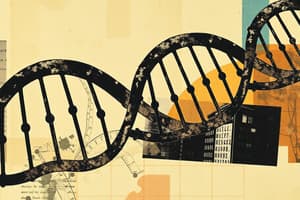Podcast
Questions and Answers
During DNA replication, which enzyme is responsible for relieving the strain ahead of the replication fork by cutting and rejoining the DNA strands?
During DNA replication, which enzyme is responsible for relieving the strain ahead of the replication fork by cutting and rejoining the DNA strands?
- Topoisomerase (correct)
- Ligase
- Helicase
- DNA Polymerase
Which of the following represents the correct flow of genetic information as described in the provided material?
Which of the following represents the correct flow of genetic information as described in the provided material?
- Protein → RNA → DNA
- RNA → DNA → Proteins
- DNA → Proteins → RNA
- DNA → RNA → Proteins (correct)
Which of the following is NOT a type of point mutation?
Which of the following is NOT a type of point mutation?
- Deletion
- Insertion
- Substitution
- Frameshift (correct)
If a DNA sequence undergoes a mutation that alters the amino acid sequence of the resulting protein, but the protein still maintains a similar function, what type of effect is this mutation MOST likely to be?
If a DNA sequence undergoes a mutation that alters the amino acid sequence of the resulting protein, but the protein still maintains a similar function, what type of effect is this mutation MOST likely to be?
A mutation in a gene results in a protein that is significantly shorter than the normal protein. Which type of mutation is MOST likely to have caused this?
A mutation in a gene results in a protein that is significantly shorter than the normal protein. Which type of mutation is MOST likely to have caused this?
What determines the specific amino acid that a tRNA molecule will carry during translation?
What determines the specific amino acid that a tRNA molecule will carry during translation?
Which enzyme is responsible for synthesizing new DNA strands during replication?
Which enzyme is responsible for synthesizing new DNA strands during replication?
What is the role of mRNA in protein synthesis?
What is the role of mRNA in protein synthesis?
What type of bond connects complementary base pairs in a DNA double helix?
What type of bond connects complementary base pairs in a DNA double helix?
If a mutation alters a DNA sequence but does NOT change the resulting amino acid sequence, it is MOST likely what type of mutation?
If a mutation alters a DNA sequence but does NOT change the resulting amino acid sequence, it is MOST likely what type of mutation?
Flashcards
What are Nucleotides?
What are Nucleotides?
The building blocks (monomers) of DNA
DNA Bases
DNA Bases
Adenine (A), Thymine (T), Guanine (G), Cytosine (C); Purines (A, G), Pyrimidines (T, C)
Shape of DNA
Shape of DNA
Double helix, similar to a twisted ladder structure.
Bonds in DNA
Bonds in DNA
Signup and view all the flashcards
DNA packaging
DNA packaging
Signup and view all the flashcards
DNA replication enzymes
DNA replication enzymes
Signup and view all the flashcards
Transcription
Transcription
Signup and view all the flashcards
Translation
Translation
Signup and view all the flashcards
Types of RNA
Types of RNA
Signup and view all the flashcards
Codon
Codon
Signup and view all the flashcards
Study Notes
DNA Structure
- The monomer is nucleotides.
- Bases include ATGC, purines, and pyrimidines.
- The shape is a double helix, like a ladder.
- Bonds are covalent and hydrogen bonds.
- Follows a complementary base pair rule.
DNA Packaging
- Uses histones, nucleosomes, and chromosomes.
DNA Replication
- Enzymes involved: helicase, topoisomerase, DNA polymerase, primase, and ligase.
- Process: 5' to 3' ends, separation of strands, addition of nucleotides, leading strand, lagging strand, okazaki fragments, joining gaps.
- Semi-conservative replication model.
Protein Synthesis
- Transcription takes place with location and structures involved, produce a product, and is labeled, RNA -> AUGC
- Translation takes place with location and structures involved, produce a product, read codon chart, codons, anticodons, know how to label
- Types of RNA: mRNA, tRNA, rRNA function of each in protein synthesis.
- Flow of genetic information: DNA -> RNA -> Proteins
- Relationship between DNA and Proteins: DNA sequence -> Amino acid sequence (mRNA) -> Protein sequence -> Protein structure -> Protein function
- Alter DNA sequence (mutation) -> Amino acid sequence altered -> Protein structure altered -> Protein function altered -> Disease or Variation in traits.
- One codon has 3 bases and codes for 1 amino acid.
- Two codons compose of 6 bases and codes for 2 amino acids.
Mutation
- Types: Substitution, insertion, deletion
- Effects: Silent, nonsense, frameshift, missense
- All mutations are not detrimental. Can be neutral, beneficial, or detrimental.
Studying That Suits You
Use AI to generate personalized quizzes and flashcards to suit your learning preferences.




